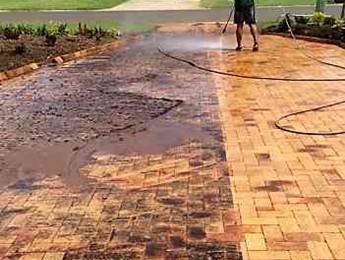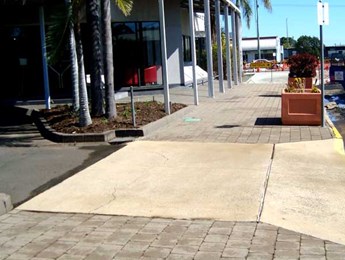How to clean pavers

Pavers are a durable long lasting masonry surface that come in many plain or decorative styles. They may be arranged to give a decorative addition to the surroundings. Although long lasting they are a great place for moss, mould and dirt to collect. Generally having a rough surface, they are great to catch fine dirt and with moisture they can be a problem.
The process to give your surface areas a thorough clean is outlined below. Another simple solution is to hire a professional Request a quote who has the equipment and knowledge to do a great, long lasting finish.
The paver cleaning specialists!
Once the area has been professionally cleaned, keeping your pavers looking good can be easy with a regular wash with a garden hose.
Book a free quote here - Quote form
To clean neglected pavements, follow the following steps for a DIY solution. Gloves and personal protection should also be worn during of cleaning your pavers.
Remove loose dirt and debris from the surface using a stiff broom or blower before wetting the area. It’s easier to collect this while dry and it can be placed in the bin.
Next step is pressure cleaning the area to remove as much of the remaining dirt, moss and mould as possible. Pressure cleaning is handy to remove the weeds with a follow up spray for weeds is necessary to prevent regrowth. Be careful not damage the pavers or blow too much of the bedding sand out by holding the nozzle too close. It doesn’t have to be perfect as this is not the final step.
If the moss has grown into the sand, it is best to remove the plants with pressure and buy a bag of bedding or paver sand to fill the gaps once again.
Pressure will remove most of the contamination but not necessarily kill the mould.
To quickly kill mould, moss and lichen a mixture of sodium hypochlorite (pool chlorine), a surfactant (soap) and water is our favourite. Household bleach usually contains chlorine but at a lower concentration and can be used. Napisan can be used to clean pavers or similar products contain mould killing ingredients. Using sodium hypochlorite to kill lichen is a best approach. To instantly remove lichen a higher concentration must be used. Cleanupcrew use expensive soft washing metering devices although you can easily mix the required concentration in a bucket or sprayer. For instant results use 6% SH for the worst areas. This means pool chlorine is generally 13% SH, so mix slightly lower than half and half , water and chlorine with a good soap for lots of bubbles.This will burn the organic systems instantly. Then easily removed with low pressure or a broom. To kill mould slowly but effectively only takes a weaker solution of chlorine , perhaps a cupful in a 2 gallon bucket and broom on or a cupful in a 5 litre spray bottle. Be very careful to thoroughly clean the spray bottle after use as chlorine is very hard on springs etc.
Surfactants (generally soap mixtures) break the surface tension and allow the other products to break the molecular bond of the dirt and kill the organics.
Care should be taken to avoid spraying friendly plants and preventing runoff from entering our waterways.
Depending on what organism, you are trying to treat may need different concentrations.
For general mould mix 1 part chlorine to ten parts water with a big squirt of household detergent per bucket.
For lichen you may need 2-3 parts chlorine and it some cases even 50 / 50 in a spray bottle to spot spray moss and lichen growths.
Mix your solution in a square bucket and apply with a broom is the easiest way. Experiment with what you have to apply an even coating.
The solution should be left on for a minimum of 20 minutes although you can leave it on areas such as driveways etc. The chlorine will dissipate over a few days leaving just the soap. If this will cause a slip hazard when it gets wet again or pets will walk on it, it is best to wash it of after treatment. For safety. You get the best results if you can leave a slight residue on the surface.
This treatment will greatly lengthen the time before the surface needs cleaning again and reduce the zebra strips after pressure cleaning as new mould grows.
If you don’t need to kill the organics immediately you can use a solution containing Benzalkonium Chloride. Products such as Wet and Forget, Wet and Forget Rapid and Glitz 5L Spray And Go all contain this chemical. Once you have cleaned the dirt off these can be applied to kill moss, lichen and mould. This is a process that happens over time and depends on the elements.
If you are cost conscious chlorine can be bought for one dollar per litre and a Benzalkonium Chloride product may cost up to fifty dollars a litre.
If you don't have the time or experience an easy affordable way to clean your pavers ( Bundaberg and surrounding areas) is contact Cleanupcrew using the links.
You can sit back with the knowledge you have made the right choice.
Call the Cleanupcrew for professional pavement cleaning on 0427 575 195 or request an obligation free, onsite quote.
Specialised services for..






